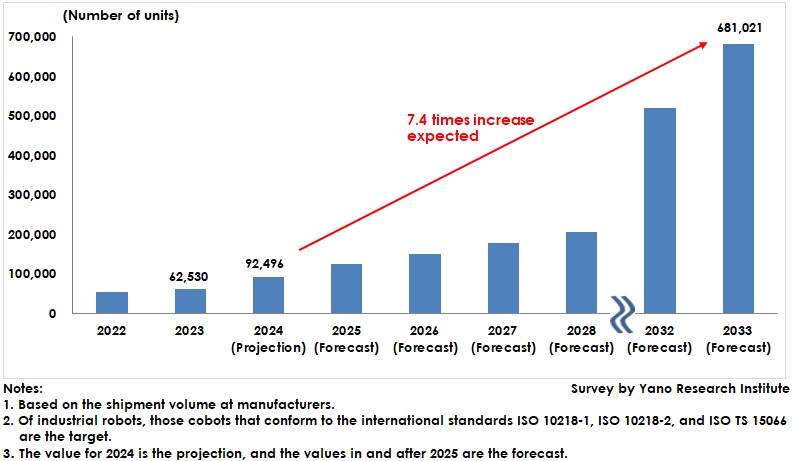No.3591
Global Collaborative Robot (Cobot) Market: Key Research Findings 2024
Global Cobot Shipment Volume Expected to Exceed 680 Thousand Units by 2033
Yano Research Institute (the President, Takashi Mizukoshi) has surveyed the global collaborative robot (cobot) market and has found out the related policies and support systems at major countries, trend of market players, and future perspectives.

Market Overview
The estimated global collaborative robot (cobot) market size in 2024 by shipment volume at manufacturers is projected to be 92,496 units, 147.9% of that of previous year.
When observing the deployment by country/region, the Chinese market sees each of cobot manufacturers strengthening sales promotions directed at SMEs in automotive or electronics industries with little automation introduced. In non-manufacturing industries, inquiries about the applications of café barista, cook at restaurants, as well as of medical and agricultural fields are increasing.
In Europe, cobot deployment promotions are reinforced for the process of producing secondary batteries and electronic parts that face repetitive workflows relying on manual work, which is growing in volume due to widespread EVs. In addition, because of stricter exporting environment to the United States stemming from worsened relationship with the country, Chinese cobot manufacturers are turning to Europe, augmenting the sales activities.
The US market has found growing demand for automating the production processes via cobots or other methods in automotive and other industries, owing to accelerated rise of manpower and material costs. Each cobot manufacturer vigorously appeals their products to the industries of automotive, secondary battery, and semiconductor, in which expansion in capital investment is observed. For non-manufacturing industries, cobot manufacturers from South Korea have targeted the food service industry to which they enthusiastically promote the cobot system applicable for cooks or baristas. Massaging robots have begun gathering attention in the US market just like in the Chinese market.
In Japan, inquiries about robot deployment are increasing in a bid to automate the manufacturing industry. Leading cobot manufacturers from around the world are entering the Japanese market one after another, striving to expand market shares through a variety of products equipped with varied specifications and prices, such as those specialized in certain industries or applications.
In South Korea, in addition to moves to expand the use of cobots in the shipbuilding industry, the cobot applications cases are widening, such as at the fighter aircraft manufacturing processes in the defense industry, at electrical grid industry, for smart agriculture, at hospitals for surgical operations, at airports, cafes, etc.
Noteworthy Topics
Artificial Intelligence Software Acts as Market Game Changer
In recent years, the combination of ICT and AI technologies to enable human-cobot interactions has led to research and development of cobots for atypical work environments. Such technological studies include IoT (sensors, data collection), wireless/high-speed communications (data transmission), bigdata/deep learning (data analytics), teachingless control, technology to streamline motion teaching, large-scale language models, digital twin, imitative learning, etc.
The studies and development are projected to elevate cobot programing and instruction work to higher levels, while making them easier at the same time. Added with improved accuracy, cobot application ranges are to expand furthermore. AI software technology that fuels cobots' higher performance and higher accuracy seems to be the very game changer of the cobot market.
Future Outlook
Automation by means of robots has gained significance not only in the manufacturing industry but also in non-manufacturing. Progress in AI and sensing technologies is likely to increase higher accuracy, higher performance and higher functionality of cobots, with expansion of deployments and applications expected.
The global cobot market size in 2033 by shipment volume at manufacturers is estimated at 681,021 units, 7.4 times larger than that projected in 2024.
Research Outline
2.Research Object: Cooperative robot (cobot) manufacturers, manufacturers of peripheral appliances and parts, robot system integration companies, cobot rental companies, and cobot-deployed companies, stores, government agencies, universities, R&D institutions, industrial associations, etc.
3.Research Methogology: Face-to-face interviews (online included) by expert researchers, and literature research
About Collaborative Robots (Cobots)
Collaborative robots or cobots are one of industrial robots that are designed to directly work with humans within a prescribed workspace. They are the industrial robots installed in the same working space as humans and can work collaboratively with humans.
Cobots in this research refer to “manipulating industrial robots” that include vertical articulated robots and horizontal articulated robots, meaning that those machinery that have three or more of axes, move by automatic control, have reprogrammable multi-purpose manipulation functions, and conform to the international standards ISO 10218-1, ISO 10218-2, and ISO TS 15066.
<Products and Services in the Market>
Industrial robots, collaborative robots (cobots), vertical articulated robots, horizontal articulated robots, SCALA (Selective Compliance Assembly Robot Arm), robot system integration
Published Report
Contact Us
The copyright and all other rights pertaining to this report belong to Yano Research Institute.
Please contact our PR team when quoting the report contents for the purpose other than media coverage.
Depending on the purpose of using our report, we may ask you to present your sentences for confirmation beforehand.